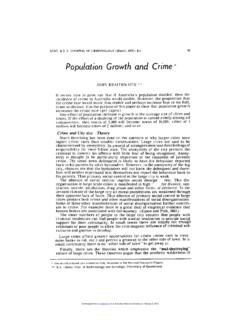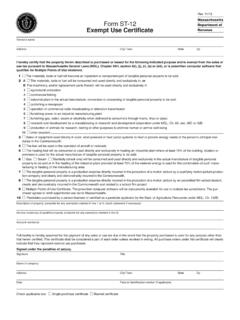Transcription of The Section 203(k) Loan Program
1 TThhee SSeeccttiioonn 220033((kk)) LLooaann PPrrooggrraammTurning Fixer-Uppers into Dream HomesAAbboouutt tthhee SSeeccttiioonn 220033((kk)) LLooaann PPrrooggrraamm If you want to buy a home that needs repair or financeneeded repairs to your current home, the Section 203(k) loan Program by the Department ofHousing and Urban Development(HUD) may be a good option for Program allows you to finance thepurchase of a house or refinance yourcurrent mortgage and include the costof its repairs through a single mortgage.
2 The Section 203(k) loan Program is HUD s primaryprogram for the rehabilitation and repair of single familyproperties. Section 203(k) loans are provided throughHUD-approved mortgage lenders nationwide and insuredby the Federal Housing Administration (FHA), which ispart of HUD. Section 203(k) refers to the law, part ofthe National Housing Act, which allows FHA to makethis mortgage insurance available. The loans are beneficialfor low- and moderate-income individuals or families sincethe loan downpayment can be as little as 3 percent.
3 Whileindividuals, local governments, and non-profit organiza-tions may participate as borrowers in the Program , the property must be used as a principal residence by an indi-vidual or family. HHooww tthhee LLooaann WWoorrkkss You can take out a Section 203(k) loan as a 15- or 30-year fixed-rate mortgage or as an Adjustable RateMortgage (ARM) from a HUD-approved lender. The totalamount of your mortgage will be based on the projectedvalue of your home after the renovation is completed, tak-ing into account the cost of the work.
4 A portion of yourloan is used to pay for the purchase of the home, or in thecase of a refinance, to pay off any existing debt. Theremainder is placed in an interest-bearing account on yourbehalf and released in stages as rehabilitation is completed. FHA requires that you use a minimum of $5,000 towardeligible repairs or improvements and that you complete therepairs within six months after the loan s closing dependingon the extent of work to be completed. This first $5,000 pri-marily covers eliminating building code violations, modern-izing, or making health and safety-related upgrades to thehome or its garage.
5 You may add minor or cosmetic repairsafter this requirement is satisfied, if applicable. You cannotinclude improvements for commercial use or luxury items,such as tennis courts, gazebos, or new swimming HHoommeessYou may use a 203(k) loan to finance the rehabilita-tion of the following types of properties. Cooperativeunits and investment properties are not one- to four-unit residence that has been com-pleted for at least one year. Examples includedetached homes and in one- to four-unit buildings(interior improvements only; additional restric-tions apply).
6 3 Mixed-use residential properties that include com-mercial of a one-unit residence to a two-,three-, or four-family of anexisting multi-unitdwelling down to a one- tofour-family existing house ormodular unit onanother site that can be moved onto the mortgagedproperty. Release of loan proceeds for the existing struc-ture on the non-mortgaged property is not allowed untilthe new foundation has been properly inspected and theresidence has been properly placed and secured to thenew that have been demolished or will be razedas part of rehabilitation work if some of the exist-ing foundation remains in place.
7 EElliiggiibbllee HHoommee IImmpprroovveemmeennttss The Section 203(k) loan covers a range of homeimprovements. These include, but are not limited to, thefollowing: Remodeling bathrooms or a kitchen, including newbuilt-in appliances Replacing a roof, gutters, and downspouts Adding a family room, bedrooms, or bathrooms Replacing flooring, tiling, or carpeting Completing a basement or attic conversion or adding asecond story Expanding or building a garage or carport Renovating a deteriorating property, such as repairing achimney, termite damage, or structural problems Upgrading plumbing, heating, air conditioning.
8 Or elec-trical wiring Eliminating health and safety hazards, such as removinglead-based paint Making the home accessible to the disabled Installing a well or a septic system Adding a porch, deck, or patio Adding or repairing siding or repainting Installing energy efficient windows or doors Repairing an existing swimming poolHHeellppffuull OOppttiioonnss If you are not planning to live in the home during con-struction, you may finance up to six months of mortgagepayments during the renovation period.
9 In addition, youmay act as your own general contractor or do the actualrepair work yourself, if you are qualified. Any money yousave this way can be used for cost overruns or additionalimprovements. You can be reimbursed only for actual mate-rial costs, not for your own labor. HHooww ttoo AAppppllyy aanndd GGeett MMoorree IInnffoorrmmaattiioonn Once you find the property that you wish to purchaseand conduct a preliminary feasibility analysis with your realestate professional, or if you are already living in the resi- dence you plan to repair, you should find a HUD-approvedlender who will help you understand the next steps anddetails of the 203(k) loan Program .
10 Because many borrowersneed professional help in determining needed repairs orimprovements, your lender will assign a 203(k) consultantto assist you in planning the work and developing cost esti-mates. The consultant will perform the home inspection,identify needed repairs or improvements, including healthand safety problems, and provide a work write-up and costestimate to you. You also can contact a HUD-approvedhousing counseling agency or check the HUD website to getmore information about the RReessoouurrcceess or details about the Section 203(k) loan programare on the HUD website in English and Housing Counseling AgencyLocatorHUD supports a network of approved housing counsel-ing agencies that provide counseling services across thenation.















